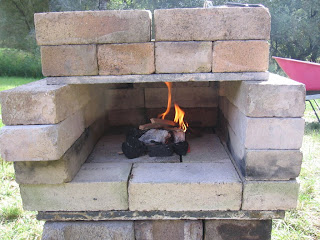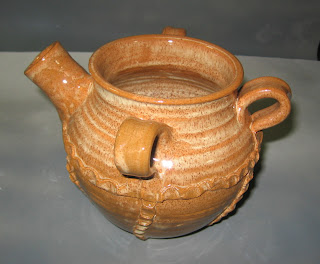QUICK BRICK BACKYARD BREAD OVEN
the completed oven in it's "shabby chic" glory
It seems like Potters love fire. Those enigmatic flames and smoke remain a mystery and a wonder even if we know much of the science of why they do what they do. Often this interest in the changes brought about by fire and smoke includes an interested in cooking.
I’ve heard of a potter claim that he makes great bread in his kiln. I couldn’t help but wonder what flour and yeast ash glaze looks like? But of course, cooking in ovens that are heated with wood was what we humans did for thousands of years before the present day. During the European Middle Ages the shape of the kiln was very similar to the shape of the bread oven.
Even in the not-too-distant past using wood as fuel was about the only option for cooking. My dad always said bread baked in an old-fashioned wood cook range was better than any other kind. Dad was not a nostalgic person as a rule, what he liked was that touch of smoke and the texture created by heat coming from all the sides surrounding the bread while it baked. For my friends and me, a lot of the enjoyment of camping trips is planning and preparing the meals. We consider that although smoky camp cooking takes much more time than food preparation in a modern kitchen, it is more than worth the trouble.
The oven with a fire just started.
When Kelly Avrill Savino posted on the Clayart list about the cob oven she made in her backyard along with clear photos and directions, I was enthralled and since then have wondered about making one of my own. Her oven was and is inspiring. http://www.primalmommy.com/earthoven.html
However, because I no longer have kids living at home and I don’t bake bread or pizza often enough to make an elaborate cob oven this was not a good decision for me. I enjoy occasionally baking bread and during those times wished I had a great outdoor oven.
Recently a friend sent me a web page titled “The One Hour Bread Oven”. http://people.umass.edu/dac/projects/BrickOven/Instant_BrickOven.htm
As I looked at it I realized that with a few tweaks, this was a perfect solution for a busy potter and could become a reality.
Most of the materials for this were lying in various places around my studio area.
The oven with the chamber opening bricked up with the bread dough inside.
As I began to plan this oven I made a personal rule that only materials already on my property could be used. The only difficulty I had was finding enough concrete blocks. It happened that what I had on hand was quite a good amount, which would be an appropriate size for my use.
Building the Quick Brick Backyard Bread Oven:
The Quick Brick oven took longer than an hour, but only because I had to scrounge up the materials, haul them to the area in which I wanted to build it, and then scrub the dirt off of them. If the materials had been all ready to go the construction would have taken less than an hour.
Materials:
12 cement blocks, 2 kiln shelves, 41 fire bricks.
Other tools: kitchen tongs, garden hoe, work gloves.
I found two different widths of cement blocks; however, they were the same height so the only disadvantage was lack of the look of symmetry. I used six cement blocks for the base and six for the second layer. I wanted two layers of cement blocks so I did not have to bend down so far to stoke the fire and to place the food in the oven.
I also gathered fire bricks and two kiln shelves. One kiln shelf was slightly warped and cracked, while the other was new and straight, but it did not fit efficiently in my kilns. These two shelves happened to be silicon carbide. Everything but the shelves had been sitting outside. So I scrubbed them all, including the shelves, with a rag and soapy water. I changed the wash water frequently.
To begin the process I found the least uneven spot possible in the back yard on which to construct the oven.
The first layer was the concrete blocks. I placed six on the ground, then using a different lattice, I laid six more concrete blocks on top of the first layer.
Next came the warped kiln shelf. It was about the right size to cover the blocks and NOT so warped that it would cause rocking.
Next came a layer of 12 fire brick to cover the kiln shelf. These fire brick constitute the floor of the oven.
Around the edge of the kiln shelf I stacked three layers of firebrick, a total of 18. They formed three sides of a rectangle. The fourth side is the mouth of the oven and is left open until food is placed in the oven. I thought three bricks would be high enough for any loaf I might bake.
Then I lay the second kiln shelf on top of the brick rectangle. This constituted the lid of the oven,
A layer of 8 firebricks were laid on the top of the kiln shelf.
Three last firebricks were left to be the cover, or door to keep the heat in after the bread is placed in the oven.
The bread is baked!
You have probably thought of a couple of questions about this structure.
There is no mortar, so there are gaps between the bricks and kiln shelves. Heat escapes through the gaps, but not too quickly. Bread still has time to bake. The firebricks hold heat effectively once they have heated up sufficiently. If a tighter oven is desired, a coil of clay would chink the most gaping of holes.
The oven is uneven and just sitting on top of the ground. As the earth moves slightly over time, the bricks will move even farther apart. If it becomes too crooked, because there is no mortar, it is easy to re-stack, or even completely re-build in a short time.

A closer view of the loaf. It was 4" at it's thickest and was done throughout.
Using the Quick Brick Backyard Oven for bread:
*To start the fire, use a few pieces of hardwood lump charcoal in a BBQ then transfer several nicely burning pieces to the oven chamber using kitchen tongs.
*Then several pieces of kindling are laid over the coals in a teepee shape until they catch fire.
*After starting the fire, the only fuel used is small dried branches and twigs from my trees. This was wood that I would have burnt in a leaf pile or hauled away.
*The small size of wood pieces burn very quickly, meaning the fire has to be fed frequently. I was gifted a bellows some time ago and use it to keep the fire burning well.
*The door bricks are moved close to the oven chamber so they also get hot.
*After at least 2 hours of heating, I hold my hand in the oven chamber. If it is too hot to keep my hand in after 3 second that is about right.
*After the bricks have heated up, the bread is brought near the oven.
*The ashes are scraped out as fast and as completely as possible with the use of a garden hoe.
*The bread should be placed in the oven towards the center. There will be a small bit of ash there, this might even add a little interesting flavor.
*It isn’t necessary to use a release agent, such as grease or cornmeal on the bricks, the bread comes off easily after it is baked.
*It is still important to work fast, have the work gloves near by, I put them on quickly and close the opening using the three bricks reserved for the door.
*Avoid Peeking for at least 50 minutes. This is the most difficult step of the entire process.
* I Check for doneness in about 50 minutes by taking one brick away. A flashlight is helpful to see in the dark interior. If the bread isn’t nicely browned, I quickly reposition the brick and give it another 15 minutes. Every time the door bricks are removed there will be heat loss which can not be replaced during that baking session.
 Interior of loaf.
Interior of loaf.
These are just my methods of building and baking in the Quick Brick Oven, they are not set in concrete. I am sure people will find their own variations in materials, structure, and baking techniques. This project is open to flexibility and creativity. I have had a wonderful time with my experiments.

















































